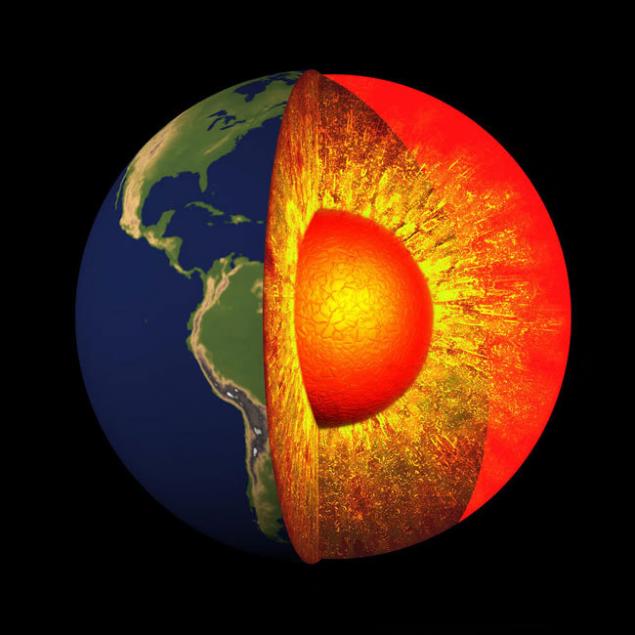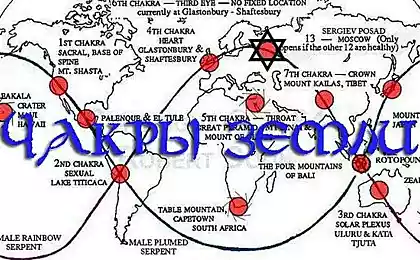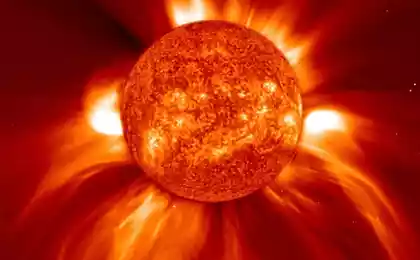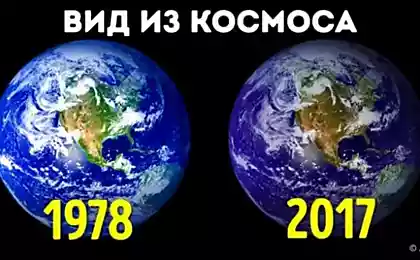643
How do we know what is at the core of the Earth?
People filled the Earth. We conquered the land, fly through the air, dived into the depths of the ocean. We even visited the moon. But we were never in the core of the planet. We are not even close to it does not pick up. The Central point of Land is 6000 kilometers away on the bottom, and even the farthest part of the core is 3000 km under our feet. The deepest hole we made on the surface is the Kola superdeep borehole in Russia, and that she goes deep into the earth at a measly 12.3 kilometer.

All known events on Earth occur close to the surface. The lava that erupts from volcanoes, first melts to a depth of several hundred kilometers. Even the diamonds who need emergency heat and pressure for education, born in the rocks at a depth of no more than 500 kilometers.
Everything below shrouded in mystery. Seems unattainable. And yet we know quite a lot about our core. We even have some idea about how it was formed billions of years ago — and all without a single physical sample. How did we manage to learn so much about the Earth's core?
First you need to think carefully about the mass of the Earth, says Simon Redfern from Cambridge University in the UK. We can estimate the mass of the Earth, observing the effect the planet's gravity that it has on objects on the surface. It turned out that the mass of Earth is 5.9 tons of Zeta-flop: 59 with twenty zeros.
But on the surface there are no signs of this mass.
"The density of the material at the Earth's surface is much lower than the average density of the whole Earth, which tells us that there is something more dense, says Redfern. This is the first".
In fact, most of the earth's mass must be located toward the center of the planet. The next step is to figure out which heavy material is the core. And it consists almost entirely of iron. 80% of the core is iron, but the exact figure will have to figure out.
The main proof of this is the huge amount of iron in the Universe around us. This is one of the ten most abundant elements in our galaxy, which is also often found in meteorites. With all this on the surface of the Earth much less iron than you would expect. According to the theory, when the Earth was formed 4.5 billion years ago, a lot of iron flowed down to the core.
There is concentrated most of the mass, and hence the iron should be there. Iron is also a relatively dense element under normal conditions, but under strong pressure in the Earth's core it will be even tighter. The iron core would explain all the missing mass.
But wait. As iron was there at all? Iron had in some way attracted to — quite literally — to the center of the Earth. But this is not happening.
Much of the rest of the Earth is composed of rocks — silicates and molten iron barely passes through them. Like water on a oily surface forms drops, iron is collected in small tanks, refusing to spread and spread.
A possible solution was discovered in 2013, Wendy Mao of Stanford University and her colleagues. They asked a question, what happens when iron and silicate are subjected to strong pressure deep in the earth.
Impacting both substances with diamonds, the scientists were able to push the molten metal through silicate. "This pressure significantly modifies the properties of the interaction of iron with silicates, says Mao. — High pressure forms a "chain melting".
This may indicate that iron was gradually slipping through the rocks of the Earth over millions of years, until it reached the core.
At this point you may ask: how do we actually know the size of the kernel? Why do scientists believe that it begins in 3000 kilometers? The answer is seismology.
When an earthquake occurs, it sends a shock wave across the planet. Seismologists record these fluctuations. If we beat on one side of the planet giant hammer and listen to the noise on the other side.
"In the 1960-ies of the earthquake in Chile, which gave us a huge amount of data, says Redfern. All seismic stations throughout the Earth recorded aftershocks of this earthquake."
Depending on the route of these vibrations, they pass through different parts of the Earth, and this affects how much sound they make on the other end.
In the early history of seismology, it became apparent that some variations are missing. These "S-wave" I expected to see at the other end of the Earth after the origin one, but never saw him. The reason is simple. S-wave reverberat through solid material and are unable to pass through the liquid.
They must have collided with something melted in the center of the Earth. Making a map of the paths S-waves, scientists have come to the conclusion that at a depth of approximately 3,000 kilometers of rocks become liquid. It also suggests that the core melted. But the seismologists there was another surprise in this story.
In the 1930-ies the Danish seismologist Inge Lehmann discovered that another type of waves, P-waves, unexpectedly passed through the core and was discovered on the other side of the planet. Was immediately followed by the assumption that the core is divided into two layers. The "inner" core that starts at 5000 miles down was hard. Molten only "outside" the kernel.
The idea Lehman was confirmed in 1970 when more sensitive seismographs showed that P-wave really pass through the kernel and, in some cases, are reflected at certain angles. It is not surprising that in the end they are on the other side of the planet.
Shock wave through the Ground sending not only the earthquake. In fact, seismologists owe a lot to the development of nuclear weapons.
A nuclear explosion also creates waves on earth, is why States turn to the seismologists during the testing of nuclear weapons. During the cold war it was extremely important, so seismologists like Lehman got a lot of support.
Competing countries have learned about the nuclear capabilities of each other and in parallel with this we learned more and more about the Earth's core. Seismology is still used for the detection of nuclear explosions today.
Now we can draw a rough picture of the structure of the Earth. There is a molten outer core, which begins about halfway to the center of the planet, and inside it is a solid inner core with a diameter of about 1220 kilometers.
Issues by no means smaller, especially the inner core. For example, how is it hot? To find out it was not so easy, and scientists have long puzzled, said Lidunka Vocadlo from University College London in the UK. We can't put the thermometer, so the only option is to create the necessary pressure in the laboratory.
Under normal conditions, iron melts at 1538 degrees
In 2013 a group of French scientists have produced the best estimate to date. They were subjected to pure iron with the pressure of half of what is in the nucleus, and repelled already from this. The melting point of pure iron in the core is approximately 6230 degrees. The presence of other materials may slightly reduce the melting point of 6000 degrees. But it's still hotter than the surface of the Sun.
Being a kind of fried potatoes, the Earth's core is hot due to the heat remaining from the formation of the planet. It also removes heat from friction as it moves dense materials, as well as decay of radioactive elements. It cools by about 100 degree centigrade every billion years.
Know this temperature is useful because it affects the rate of passage of oscillation through the core. And this is useful because in these vibrations there is something strange. P-waves travel through unexpectedly slow inner core is slower than if it consisted of pure iron.
"The speed of the waves, which seismologists measured the earthquake is much lower than that shown by experiment or computer calculation, says Vocadlo. — No one yet knows why it is so".
Obviously, to iron mixed with other material. Perhaps Nickel. But scientists considered as the seismic waves must pass through the Nickel-iron alloy, and are unable to adjust the calculations under observation.
Vocadlo and her colleagues are currently considering the possibility of the presence in the nucleus of other elements such as sulfur and silicon. No one was able to come up with a theory of the composition of the inner core that would satisfy all. Problem Cinderella: the slipper does not fit anyone. Vocadlo trying to experiment with the materials of the inner core on the computer. She hopes to find a combination of materials, temperatures and pressure, which will slow down the seismic waves at the correct value.
She says the secret may be hiding in the fact that the inner core is nearly at the melting point. As a result, accurate material properties can differ from those that would belong to a completely solid substance. Also this could explain why seismic waves pass more slowly than expected.
"If this effect is real, we could reconcile the results of mineral physics with the results of seismology, says Vocadlo. — People can't do it."
There are still many mysteries related to the Earth's core, which must be solved. But not being able to dive to the incredible depths, scientists make the feat of figuring out which is thousands of kilometres beneath us. The hidden processes of the Earth, it is extremely important to study. The Earth has a powerful magnetic field, which is generated due to partially melted core. The constant movement of the molten core generates an electric current inside the planet, and he, in turn, generates a magnetic field that goes far into space.
This magnetic field protects us from harmful solar radiation. Don't be the core of the Earth the way it is, there would be no magnetic field, and we would seriously suffer from it. Hardly anyone of us will be able to see the core with my own eyes, but it's good just to know that it is there. published
P. S. And remember, only by changing their consumption — together we change the world! ©
Source: hi-news.ru

All known events on Earth occur close to the surface. The lava that erupts from volcanoes, first melts to a depth of several hundred kilometers. Even the diamonds who need emergency heat and pressure for education, born in the rocks at a depth of no more than 500 kilometers.
Everything below shrouded in mystery. Seems unattainable. And yet we know quite a lot about our core. We even have some idea about how it was formed billions of years ago — and all without a single physical sample. How did we manage to learn so much about the Earth's core?
First you need to think carefully about the mass of the Earth, says Simon Redfern from Cambridge University in the UK. We can estimate the mass of the Earth, observing the effect the planet's gravity that it has on objects on the surface. It turned out that the mass of Earth is 5.9 tons of Zeta-flop: 59 with twenty zeros.
But on the surface there are no signs of this mass.
"The density of the material at the Earth's surface is much lower than the average density of the whole Earth, which tells us that there is something more dense, says Redfern. This is the first".
In fact, most of the earth's mass must be located toward the center of the planet. The next step is to figure out which heavy material is the core. And it consists almost entirely of iron. 80% of the core is iron, but the exact figure will have to figure out.
The main proof of this is the huge amount of iron in the Universe around us. This is one of the ten most abundant elements in our galaxy, which is also often found in meteorites. With all this on the surface of the Earth much less iron than you would expect. According to the theory, when the Earth was formed 4.5 billion years ago, a lot of iron flowed down to the core.
There is concentrated most of the mass, and hence the iron should be there. Iron is also a relatively dense element under normal conditions, but under strong pressure in the Earth's core it will be even tighter. The iron core would explain all the missing mass.
But wait. As iron was there at all? Iron had in some way attracted to — quite literally — to the center of the Earth. But this is not happening.
Much of the rest of the Earth is composed of rocks — silicates and molten iron barely passes through them. Like water on a oily surface forms drops, iron is collected in small tanks, refusing to spread and spread.
A possible solution was discovered in 2013, Wendy Mao of Stanford University and her colleagues. They asked a question, what happens when iron and silicate are subjected to strong pressure deep in the earth.
Impacting both substances with diamonds, the scientists were able to push the molten metal through silicate. "This pressure significantly modifies the properties of the interaction of iron with silicates, says Mao. — High pressure forms a "chain melting".
This may indicate that iron was gradually slipping through the rocks of the Earth over millions of years, until it reached the core.
At this point you may ask: how do we actually know the size of the kernel? Why do scientists believe that it begins in 3000 kilometers? The answer is seismology.
When an earthquake occurs, it sends a shock wave across the planet. Seismologists record these fluctuations. If we beat on one side of the planet giant hammer and listen to the noise on the other side.
"In the 1960-ies of the earthquake in Chile, which gave us a huge amount of data, says Redfern. All seismic stations throughout the Earth recorded aftershocks of this earthquake."
Depending on the route of these vibrations, they pass through different parts of the Earth, and this affects how much sound they make on the other end.
In the early history of seismology, it became apparent that some variations are missing. These "S-wave" I expected to see at the other end of the Earth after the origin one, but never saw him. The reason is simple. S-wave reverberat through solid material and are unable to pass through the liquid.
They must have collided with something melted in the center of the Earth. Making a map of the paths S-waves, scientists have come to the conclusion that at a depth of approximately 3,000 kilometers of rocks become liquid. It also suggests that the core melted. But the seismologists there was another surprise in this story.
In the 1930-ies the Danish seismologist Inge Lehmann discovered that another type of waves, P-waves, unexpectedly passed through the core and was discovered on the other side of the planet. Was immediately followed by the assumption that the core is divided into two layers. The "inner" core that starts at 5000 miles down was hard. Molten only "outside" the kernel.
The idea Lehman was confirmed in 1970 when more sensitive seismographs showed that P-wave really pass through the kernel and, in some cases, are reflected at certain angles. It is not surprising that in the end they are on the other side of the planet.
Shock wave through the Ground sending not only the earthquake. In fact, seismologists owe a lot to the development of nuclear weapons.
A nuclear explosion also creates waves on earth, is why States turn to the seismologists during the testing of nuclear weapons. During the cold war it was extremely important, so seismologists like Lehman got a lot of support.
Competing countries have learned about the nuclear capabilities of each other and in parallel with this we learned more and more about the Earth's core. Seismology is still used for the detection of nuclear explosions today.
Now we can draw a rough picture of the structure of the Earth. There is a molten outer core, which begins about halfway to the center of the planet, and inside it is a solid inner core with a diameter of about 1220 kilometers.
Issues by no means smaller, especially the inner core. For example, how is it hot? To find out it was not so easy, and scientists have long puzzled, said Lidunka Vocadlo from University College London in the UK. We can't put the thermometer, so the only option is to create the necessary pressure in the laboratory.
Under normal conditions, iron melts at 1538 degrees
In 2013 a group of French scientists have produced the best estimate to date. They were subjected to pure iron with the pressure of half of what is in the nucleus, and repelled already from this. The melting point of pure iron in the core is approximately 6230 degrees. The presence of other materials may slightly reduce the melting point of 6000 degrees. But it's still hotter than the surface of the Sun.
Being a kind of fried potatoes, the Earth's core is hot due to the heat remaining from the formation of the planet. It also removes heat from friction as it moves dense materials, as well as decay of radioactive elements. It cools by about 100 degree centigrade every billion years.
Know this temperature is useful because it affects the rate of passage of oscillation through the core. And this is useful because in these vibrations there is something strange. P-waves travel through unexpectedly slow inner core is slower than if it consisted of pure iron.
"The speed of the waves, which seismologists measured the earthquake is much lower than that shown by experiment or computer calculation, says Vocadlo. — No one yet knows why it is so".
Obviously, to iron mixed with other material. Perhaps Nickel. But scientists considered as the seismic waves must pass through the Nickel-iron alloy, and are unable to adjust the calculations under observation.
Vocadlo and her colleagues are currently considering the possibility of the presence in the nucleus of other elements such as sulfur and silicon. No one was able to come up with a theory of the composition of the inner core that would satisfy all. Problem Cinderella: the slipper does not fit anyone. Vocadlo trying to experiment with the materials of the inner core on the computer. She hopes to find a combination of materials, temperatures and pressure, which will slow down the seismic waves at the correct value.
She says the secret may be hiding in the fact that the inner core is nearly at the melting point. As a result, accurate material properties can differ from those that would belong to a completely solid substance. Also this could explain why seismic waves pass more slowly than expected.
"If this effect is real, we could reconcile the results of mineral physics with the results of seismology, says Vocadlo. — People can't do it."
There are still many mysteries related to the Earth's core, which must be solved. But not being able to dive to the incredible depths, scientists make the feat of figuring out which is thousands of kilometres beneath us. The hidden processes of the Earth, it is extremely important to study. The Earth has a powerful magnetic field, which is generated due to partially melted core. The constant movement of the molten core generates an electric current inside the planet, and he, in turn, generates a magnetic field that goes far into space.
This magnetic field protects us from harmful solar radiation. Don't be the core of the Earth the way it is, there would be no magnetic field, and we would seriously suffer from it. Hardly anyone of us will be able to see the core with my own eyes, but it's good just to know that it is there. published
P. S. And remember, only by changing their consumption — together we change the world! ©
Source: hi-news.ru























